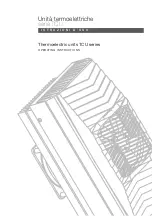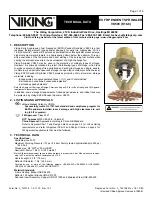
5
t
848 Airport Road, Walla Walla, Washington 99362 U.S.A.
Tel: +1 509.525.7660 / Fax: +1 509.525.7907
twigwirelesscontrols.com
2.0 OvERvIEw Of SySTEM COMPOnEnTS
The wireless control system is built with Nelson’s powerful radios
inside the TD200 controller and the TWIG field units. Two way
communication is between the TD200 and the TWIGs. These join
together to make a field network.
2.1 ThE COnTROllER AnTEnnA:
The antenna for the TD200 is the communication focal point
for signals to and from the field. Take great care in locating the
antenna. Typical mounting elevation is 20-30’ high if possible but
not more than 50’. A clear line-of-sight between the TD200 and
the TWIGs is essential for strong communications. The network is
made when the TWIGs join up to the TD200 controller.
2.2 ThE TwIG hAS InTERnAl AnTEnnAS:
Each TWIG has internal antennas that send and receive. To work it must receive the TD200 signal. The
TWIG has a display for configuration so it can easily be setup in the field. It is important that the TWIG
box be in the upright position to get a good signal (don’t lay the TWIG box on back or side). You may be
able to get slightly better antenna strength if the box door latches are lined up toward the controller. More
information about TWIG setup is in Section 3.
2.3 COnTROllER SIGnAl AnD vAlvE RESPOnSE TIME:
The TWIG system communicates every 20 seconds which provides good
response time. However, radio transmissions are sent to check and confirm
valve status at the top of the minute. Remember valves may take a few sec-
onds to actually change switching open or close.
2.4 MUlTI-vAlvE TwIGS CAn OPERATE MORE
ThAn OnE vAlvE:
One advantage to having valves close together is that a multi-valve TWIG is able to operate up to four valves.
A pair of wires is connected to each of the valve solenoids and the TD200 recognizes each one as an indepen-
dent valve by the last digit in the TWIG ID (1,2,3 or 4). Extension wires to solenoid should be not more than 50
ft long. More information about wire connection is in Section 7.
2.5 bATTERy lIfE IS wEll MAnAGED by TwIGS:
The TWIG is designed to manage battery life using a latency
(deep sleep) technology to get the longest service life. Two
“D-cell” batteries in the TWIG typically work for a whole sea-
son. Standard alkaline batteries were selected because they
are readily available.
TWIG
note
PlAn TO REPlACE bATTERIES
AnnUAlly On A REGUlAR bASIS
(SOME USERS DO IT AT ThE START
Of ThE SEASOn).
antenna
Antenna mounting
is typically on a
pole about 20 ft
high. That can
vary depending
upon line of sight.
TWIG
note
SAfETy PRESSURE
RElIEf IS An IM-
PORTAnT PART Of
A GOOD DESIGn
AnD hAvInG IT IS
ThE fIRST RUlE Of
AUTOMATIOn.






































